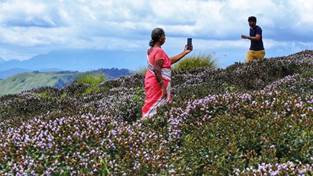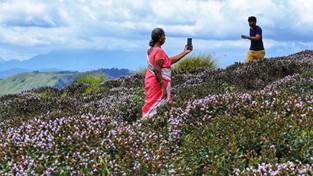Description

Disclaimer: Copyright infringement not intended.
Context: The Ministry of Environment, Forest and Climate Change (MoEF) has listed Neelakurinji ( Strobilanthes kunthiana) under Schedule III of the Wildlife (Protection) Act, 1972, including it on the list of protected plants.
.jpeg)
Details:
- Those who uproot or destroy the plant will invite a fine of ₹25,000 and three years’ imprisonment. The cultivation of Neelakurinji and its possession is not allowed, according to the order.
- Neelakurinji has been included on the list when the Centre expanded the earlier protected list of six plant species to 19.
- Destroying and uprooting of Neelakurinji plants is a major threat to the flowering areas. Normally, the Chief Wildlife Warden issues a statement to the effect that destroying Neelakurinji plants and flowers is a punishable offence under the Wildlife Protection Act and action will be taken accordingly. But it does not prevent the offence.

About:
- The plant was endemic to a small stretch in the Western Ghats from the Mangaladevi hills to the Nilgiris hills.
- In the Western Ghats region, nearly 70 varieties of Neelakurinji plants have been identified.
- The most popular Neelakurinji is Strobilanthes kunthiana which blooms once in 12 years. However, some other rare varieties of Neelakurnji are also found in the Western Ghats region.
- The Eravikulam National Park, near Munnar, is known for widespread blooming of the kurinji, with the next flowering season expected in 2030.
- The Neelakurinji is a shrub of the Acanthaceae family that famously blooms once every 12 years.
- Strobilanthesis a genus of about 350 species of flowering plants in the family Acanthaceae, mostly native to tropical Asia and Madagascar
- The Topli Karvy (Strobilanthes sessilis), the Karvy (Strobilanthes callosa) and the Kurinji (Strobilanthes kunthiana), all belong to the Strobilanthesgenus
- The external resemblance of these flowers being taxonomically related, is very similar. People can often get confused.
- The Topli Karvyis found more in the northern section of the Western Ghats in Maharashtra. It is called so since it resembles and inverted basket
- The Karvy(Strobilanthes callosa) grows on the steepest cliffs where trees can’t grow.
- The Topli Karvygrows on the plateaus of the northern Western Ghats on the other hand.
- The Neelakurinji on the other hand grows in the shola grasslands of the southern Western Ghats, which are not found in Maharashtra
- Neelakurinji was endemic to the southern Western Ghats and higher reaches of the Eastern Ghats.
https://www.thehindu.com/sci-tech/energy-and-environment/centre-casts-safety-net-for-neelakurinji-puts-it-on-protected-list/article66370057.ece












